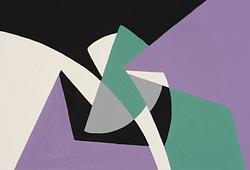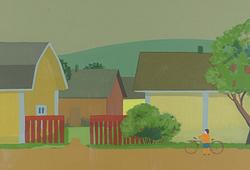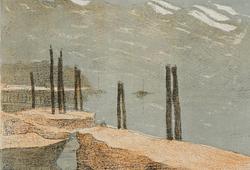Nils von Dardel
”Midsommar”
Signed Dardel and dated 1924. Watercolour on paper mounted to cardboard 50 x 65 cm.
Provenance
Hjalmar Gabrielsson's collection, Långedrag, Sweden, no 20.
Karin Folkow, Gothenburg.
Private collection, Gothenburg.
Exhibitions
Liljevalchs konsthall, Stockholm, "Nils Dardel", September - October, 1939, cat. no 149.
Kunstnernes Hus, Oslo, "Den svenske maler Nils Dardel", 1 - 23 December, 1939, cat. no 85.
Liljevalchs konsthall, Stockholm, ”Nils Dardel”, 25 March - 1 May 1955, cat. no 459.
Literature
"Konst i svenska hem", vol. II, listed under colelction 1071: "Gabrielson, Hjalmar, Direktör, Långedrag".
Karl Asplund, "Nils Dardel. II. De senare åren 1922-1943", Sveriges Allmänna Konstförening, Publication LXVII, 1958, mentioned and illustrated in black and white p.68.
More information
In 1924, Nils Dardel created the playful and national romantic motif “Midsummer” in two versions – a watercolor and an oil painting. The oil painting was part of the Kunsthalle Hamburg collection before the outbreak of the Second World War but has since been lost. The watercolor of the same title has been preserved and is presented in this auction.
The present work has the character of a theatrical sketch, lacking the personal confessions typical of Dardel and the eccentric, embedded details that often distinguish his work. The motif Midsummer can be seen as a reflection on the joyful days of The Swedish Ballet in 1920s Paris. The ballet, founded by Dardel’s friend Rolf de Maré and choreographer Jean Börlin, was at the time the world’s third-largest independent private ensemble.
Initially, its orientation was national romantic, and the production Midsummer Vigil was staged in 1920 with set and stage design by Nils Dardel. The music was strongly influenced by Swedish folk tradition. In the collections of the Dansmuseet in Stockholm, several of Dardel’s set and costume sketches for Midsummer Vigil are preserved. Over time, The Swedish Ballet became increasingly influenced by the avant-garde – modern dance made its entry hand in hand with leading composers and visual artists of the period, as an expression of both expressionism and modernism.
Karl Asplund writes about the motif and the lost painting:
“Thus, in the oil painting Midsummer, 1924 (formerly in the Kunsthalle in Hamburg, now lost, perhaps through Hitler’s ‘cleansing action’), he returns to the midsummer fantasy from the days of the Swedish Ballet. Among the white birches of Leksand march the fiddler in traditional Dalarna costume and the cheerful conscript with his hand accordion, leading a dense group of smiling men and women – a humorous Dardelian variant of Zorn’s youthful composition To the Dance. Here one is reminded of Dardel’s youthful enthusiasm for the great master from Mora. A watercolor with the same composition is preserved.”
Caption: Scen from the Ballets suédois production Midsummer Vigil in Paris, 1920. Photographer unknown.


































































